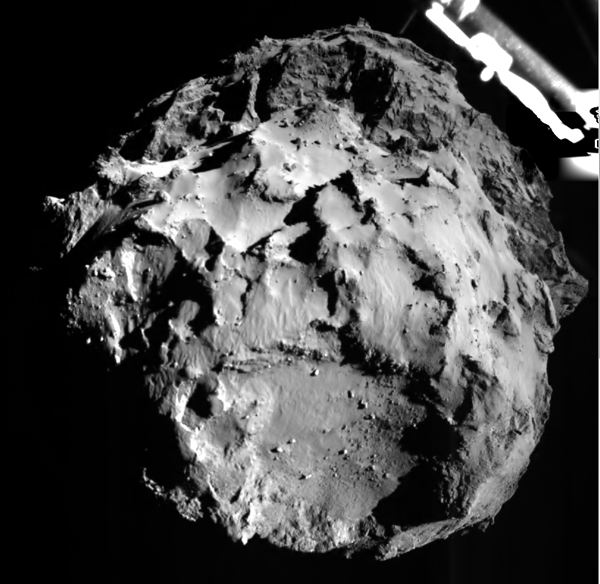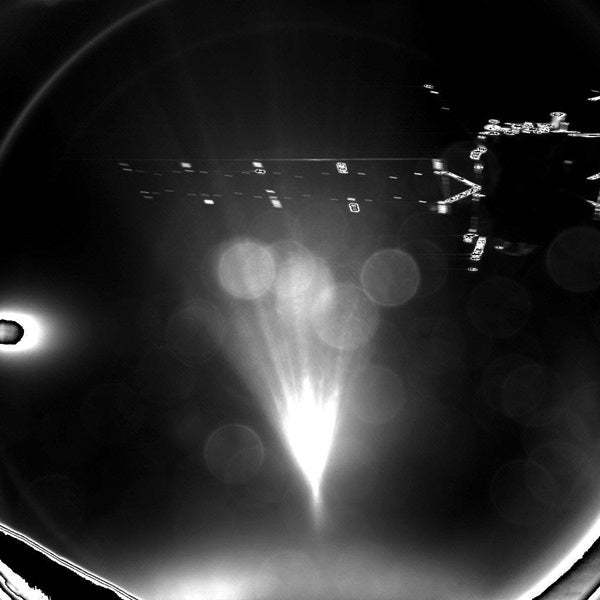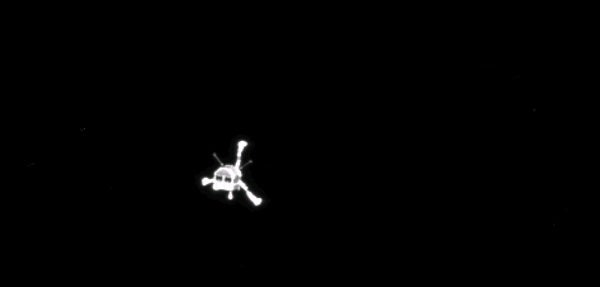After a tense wait during the seven-hour descent to the surface of Comet 67P/Churyumov–Gerasimenko, the signal confirming the successful touchdown arrived on Earth at 16:03 GMT (11:03 a.m. EST) today.
The confirmation was relayed via the Rosetta orbiter to Earth and picked up simultaneously by ESA’s ground station in Malargüe, Argentina, and NASA’s station in Madrid, Spain. The signal was immediately confirmed at ESA’s Space Operations Centre, ESOC, in Darmstadt, and DLR’s Lander Control Centre in Cologne, both in Germany.
The first data from the lander’s instruments were transmitted to the Philae Science, Operations and Navigation Centre at France’s CNES space agency in Toulouse.
“Our ambitious Rosetta mission has secured a place in the history books: Not only is it the first to rendezvous with and orbit a comet, but it is now also the first to deliver a lander to a comet’s surface,” noted Jean-Jacques Dordain, ESA’s director general. “With Rosetta we are opening a door to the origin of planet Earth and fostering a better understanding of our future. ESA and its Rosetta mission partners have achieved something extraordinary today.”
The landing site, named Agilkia and located on the head of the bizarre double-lobed object, was chosen just six weeks after Rosetta’s arrival August 6 based on images and data collected at distances of 20 to 60 miles (30 to 100 kilometers) from the comet. Those first images soon revealed the comet as a world littered with boulders, towering cliffs, and daunting precipices and pits, with jets of gas and dust streaming from the surface.
Following a period spent at 6 miles (10km) to allow further close-up study of the chosen landing site, Rosetta moved onto a more distant trajectory to prepare for Philae’s deployment.
Five critical go/no-go decisions were made last night and early this morning, confirming different stages of readiness ahead of separation, along with a final pre-separation maneuver by the orbiter.
Deployment was confirmed at 09:03 GMT (4:03 a.m. EST) at a distance of 14 miles (22.5km) from the center of the comet. During the seven-hour descent, which was made without propulsion or guidance, Philae took images and recorded information about the comet’s environment.
“One of the greatest uncertainties associated with the delivery of the lander was the position of Rosetta at the time of deployment, which was influenced by the activity of the comet at that specific moment, and which in turn could also have affected the lander’s descent trajectory,” said Sylvain Lodiot, ESA Rosetta spacecraft operationsmanager. “Furthermore, we’re performing these operations in an environment that we’ve only just started learning about, 510 million kilometers [320 million miles] from Earth.”
Touchdown was planned to take place at a speed of around 3 feet per second (1 meter per second), with the three-legged landing gear absorbing the impact to prevent rebound and an ice screw in each foot driving into the surface.
But during the final health checks of the lander before separation, a problem was detected with the small thruster on top that was designed to counteract the recoil of the harpoons to push the lander down onto the surface. The conditions of landing along with the exact location of Philae on the comet are being analyzed.
“It’s complicated to land on a comet, and it’s not only complicated to land, but it’s also as it appears very complicated to understand what has happened during this landing or after this landing,” said Stephan Ulamec, Philae lander manager at the DLR German Aerospace Center, hours after touchdown. The lander sent back science data and health information, but some of the data were a little confusing, especially after scientists discovered the lander’s harpoons, which would anchor Philae to the surface, did not fire.
“We looked into the data, and it’s interesting, and we still do not fully understand what has happened,” Ulamec said. “Some of these data indicated that the lander may have lifted off again. … So maybe today we didn’t just land once, we even landed twice.”
Science highlights from the primary phase will include a full panoramic view of the landing site, including a section in 3-D, high-resolution images of the surface immediately underneath the lander, on-the-spot analysis of the composition of the comet’s surface materials, and a drill that will take samples from a depth of 9 inches (23 centimeters) and feed them to an onboard laboratory for analysis.
The lander will also measure the electrical and mechanical characteristics of the surface. In addition, low-frequency radio signals will be beamed between Philae and the orbiter through the nucleus to probe the internal structure.
The detailed surface measurements that Philae makes at its landing site will complement and calibrate the extensive remote observations made by the orbiter covering the whole comet.
“Rosetta is trying to answer the very big questions about the history of our solar system. What were the conditions like at its infancy and how did it evolve? What role did comets play in this evolution? How do comets work?” said Matt Taylor, ESA Rosetta project scientist. “Today’s successful landing is undoubtedly the cherry on the icing of a 4 kilometer-wide cake, but we’re also looking further ahead and onto the next stage of this groundbreaking mission as we continue to follow the comet around the Sun for 13 months, watching as its activity changes and its surface evolves.”
While Philae begins its close-up study of the comet, Rosetta must maneuver from its post-separation path back into an orbit around the comet, eventually returning to a 12-mile (20km) orbit on 6 December.
Next year, as the comet grows more active, Rosetta will need to step further back and fly unbound “orbits,” but dipping in briefly with daring flybys, some of which will bring it within just 5 miles (8km) of the comet center.
The comet will reach its closest distance to the Sun on August 13, 2015, at about 115 million miles (185 million km), roughly between the orbits of Earth and Mars. Rosetta will follow it throughout the remainder of 2015 as they head away from the Sun and activity begins to subside.
“It’s been an extremely long and hard journey to reach today’s once-in-a-lifetime event, but it was absolutely worthwhile. We look forward to the continued success of the great scientific endeavor that is the Rosetta mission as it promises to revolutionize our understanding of comets,” said Fred Jansen, ESA Rosetta mission manager.












